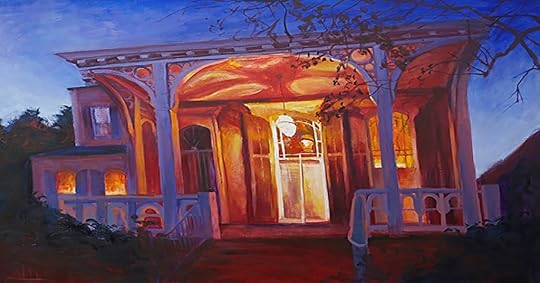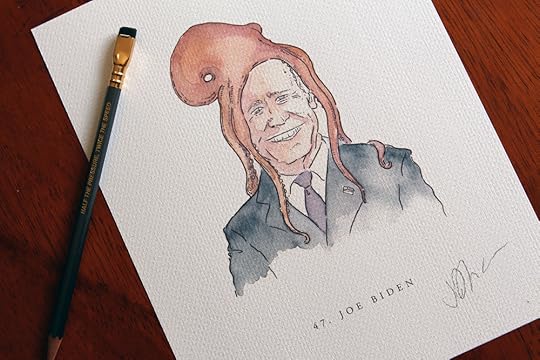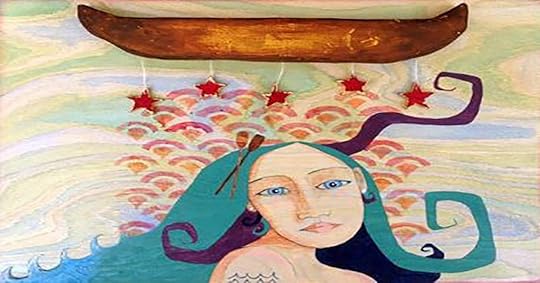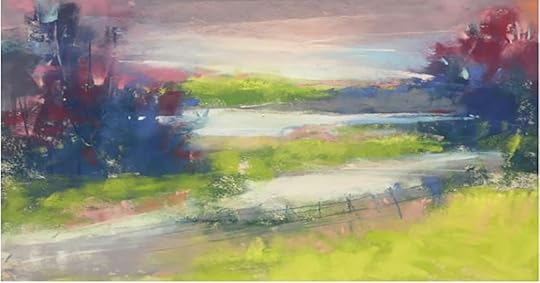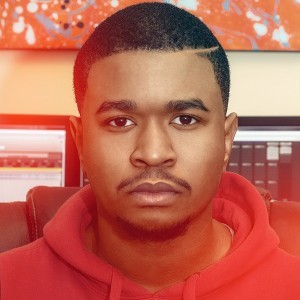Cory Huff's Blog: The Abundant Artist Goodreads blog, page 29
January 5, 2017
Adam K Hall, New Orleans Artist and TAA Case Study
The following is a letter than Adam Hall shared in TAA’s private Facebook group for TAA students. Adam took How to Sell Your Art Online in 2013, when it was still called Content Marketing for Artists. At the time, Adam did a case study which you can view here. It’s been not quite three years since Adam finished the course, and as you’ll read below, he’s made a ton of progress, including having a single month where he sold over $12,000 worth of art.
We share this with Adam’s permission. We did not ask him to write it.
Hi TAA,
It has been three years since I took the TAA class and I wanted to share what I think were the causes for my success. I have been looking back at the numbers and since taking the class I have had about ten percent growth for three years and I just had my best month ever in November making almost twelve thousand dollars in gross sales. So I thought I would share what I think that I gained from the course and why things seem to be trending upward.
1. Pride.
This one is the hardest to explain but might be the most powerful. When I took the class I was feeling desperate. The class helped me to see the beauty in my own work and to be interested in my own story. I was kind of burnt out and taking the class helped me to get closer to my inspiration and shout it from the rooftops. With the help of the facebook support group, I found my voice and I still have that sense of adventure with my artwork and people can sense that.
2. Newsletter Consistency
I am not claiming that I always write the most interesting newsletter or that people read every one. But it lets people know that I am still here and if they have a project they should get in touch with me. I just sent one out today and was contacted by two customers that wanted to know about paintings they had seen earlier. Just having a consistent way to show people that your still making artwork is hugely important. Because you never know when they have a new house, a wedding or some project that you can take on. I wish my newsletters now were as compelling as the ones I wrote in the class. But I am glad they have been consistent because I think that gives me an advantage.
3. Have Something Expensive to Sell, or Something Cheap, or Both!
Expensive
Looking back I find that a lot of my big sales are larger more expensive paintings. I don’t think these things sell consistently but there are people with big walls and you can meet their needs with large artworks. This is the easiest one to do but it seems impossible to some people.
Cheap
Prints! I make a large part of my income with prints now and I could not have done it without the class. I have a lot of neuroses about prints and I am not the only one. I used the class as a sounding board for ways to go about making prints. I found a way to do it with integrity that I like and my neuroses are less.
So thank you, Cory Huff, and thank you TAA group. I have some wonderful things in my life that you helped me to get.
The post Adam K Hall, New Orleans Artist and TAA Case Study appeared first on Online Marketing for Artists.
Successful Crowdfunding Campaign Case Study with Jonathan Crow of Veeptopus
This video is an excerpt of a chat with Jonathan Crow, who took our How to Sell Your Art Online course. You can learn more about the course at this link. My questions and summaries of Jonathan’s responses follow.
Jonathan Crow is an illustrator most known for his Veeptopus drawings – pictures of Vice Presidents of the USA with octopuses on their heads.
Where was your art business before you took How to Sell Your Art Online?
Jonathan had received a lot of press in 2014 from sites like Boing Boing. His Etsy sales were doing really well, but they started tapering off. He didn’t know what to do to revive those sales.
What was your biggest takeaway?
“Your course is very good at unpacking the things that you need to do in order to get this thing to run. And to be a more confident about getting yourself out there, which is something I think me and a lot of other artists find taxing and exhausting.”
Jonathan pointed out that he had heard many of the things in the course before, but having a consistent structure got him to actually do the work.
What does your art business look like now?
He’s doing a Kickstarter campaign. You can see it here. He successfully raised $15,137. More than enough to get his book printed and shipped.
Part of the reason his Kickstarter campaign was successful was because he was promoted at the top of his category on the website, and also made it into a few emails to the Kickstarter mailing list. That took him from 40% to 80%.
Jonathan had conceptualized the book a while ago, but he had a challenge figuring out how to turn it into a book that the publishers would publish. After several rejections, he decided to self publish.
After Jonathan and I had a conversation, Jonathan said, “You said the right thing that made me cross the line finally and say I’m gonna do it.”
Part of the reason that his idea worked was because it was a clearly conceptualized concept that just needed funding.
If someone were thinking about taking the course, what would you say to them?
It depends on where they are in their career. They could probably get something out of it on any level.
The first third works best for people who are just getting started, people who are drawn to making art but don’t really know why.
“The second third is for people who are like me,” he says. “We kinda know what we’re doing artistically, but there’s a whole business side we have no idea about.”
The third part is even more of that.
We took a slight detour to talk about how Kickstarter’s curation process, and how Jonathan took advantage of that. We referenced my interview with Willa Koerner, Kickstarter’s Head of Curation.
The post Successful Crowdfunding Campaign Case Study with Jonathan Crow of Veeptopus appeared first on Online Marketing for Artists.
How to Sell Your Art Online Case Study with Lea K Tawd
This video is an excerpt from a conversation with Lea Tawd, who took the How to Sell Your Art Online course by The Abundant Artist. Learn more about the course here. Below are my notes on my questions and responses.
What happens when you are a commission artist and people start asking you to make art that you are ambivalent about? For most artists, the projects are unfulfilling and they start to create a creative block. In this interview, Lea Taw outlines how she overcomes this problem by doing a better job screening her commissions for artistic fit.
Where was your art business when you signed up for How to Sell Your Art Online?
Lea was just getting back to selling her art after taking maternity leave. Sales were slow and she had lost some of her momentum.
What are your big takeaways from the course?
Taking action. Any action begets more action. Art is already a form of storytelling, so taking those stories further into words is a really good way to connect with people. The course heavily emphasizes learning how to tell your story as an artist. Those stories help you make more connections, more sales, and the story makes things more fulfilling for the buyer and for the artist.
Where is your art business at right now?
Lea just joined an artist collective in downtown Portland. She’s had several commissions for portraits and murals.
Lea feels that through the course and her interactions in the peer Facebook group, she has been able to hone her commission work to be truer to her own vision instead of what she thinks the client wants.
“I don’t do just any portrait. I do what I do.”
Lea has learned that she can turn potential commission gigs away if they are not a good fit, and this has allowed her to raise her prices and do a better job with the commissions she takes on.
Lea has taken on commission projects that she didn’t feel good about before, and even though the customer came away happy, for her, “doing the work didn’t feel good.”
What does your marketing look like right now?
Primarily my Instagram. She also has a regular blog, which she writes in advance so they go live at a scheduled time. She also has a mailer that she sends out to targeted businesses like yoga studios and feminist book stores, which are a good fit for her art.
The post How to Sell Your Art Online Case Study with Lea K Tawd appeared first on Online Marketing for Artists.
Graphic Designer to Full Time Artist – How to Sell Your Art Online Case Study with Anne Kindl
This is a case study with Anne Kindl, who took the How to Sell Your Art Online course with The Abundant Artist. You can see the course here. A summary of my questions and Anne’s responses are below.
NOTE: The video starts abruptly because we cut out some unrelated personal discussion from the beginning of the video. This clip is from a longer informal discussion about the course.
Anne Kindl is an artist based in Lexington, Kentucky. She primarily makes landscapes in pastels.
Anne first took How to Sell Your Art Online in January 2014. She had previously been a graphic designer, and transitioned into being a professional artist after some health challenges.
When she got out of college she hadn’t learned computer skills, but the art industry had all moved to computers. She felt like the Internet was a similar change to the fine art world.
What was your thought process like when signing up for the course?
When Anne first dove into the course, she said, “there’s a lot here.” She took her time to work through it at her own pace.
NOTE: since Anne took the course, we have broken the course into multiple parts, making it much easier to work through the material. We do a major revision every year on the course, and there’s been 3 revisions since she took it.
The course offers lots of ideas for various kinds of marketing. Anne said that she initially felt comfortable with using Facebook and Instagram, but it took her a while to get used to the idea of using her website as the central hub for her marketing. Ann likes How to Sell Your Art Online because the course introduces you to all of the options, and you can then pick which marketing activities you want to do.
What does your art business look like now?
Anne’s art business is really healthy. She has a studio in downtown Lexington, Kentucky, where the orchestra and other arts organizations are housed. She’s done several shows and turned a profit (after paying for her studio and supplies) of $35,000.
(By the way, if you didn’t know, Lexington, Kentucky has a thriving arts scene. Check out LexArts at http://lexarts.org/ )
What’s working in your marketing?
My Instagram! Ann created a series of new work, where she posted every single day for a year. Her 365 Meditations led to her being featured on the local news, some other magazine publications, and led to several other big projects, including:
– Steady sales
– Increased private class enrollment
– Success with online pop up & unique boutique events (historical venues, farm to table menu, bourbon, live music)
– Gallery exhibits with Art in Healing Foundations in two states
– Feature artist video for Creative Lexington
– Featured in Kentucky Better Homes and Gardens.
How did you come up with the idea for the series of art that you made?
After taking How to Sell Your Art Online, Ann realized that working in a series is really important. She was attempting to be a more loose, abstract artist, so this new series was a way for her to explore those themes in her art.
How long does it take to become a successful artist?
Ann did it in two years. Cory talks a little bit about how for many artists, a more realistic timeline is 3 – 5 years for artists who know what they’re trying to do and educate themselves on the right steps.
Should someone take the How to Sell Your Art Online course?
Yes, but you have to do the work. You actually have to do the suggested work assignments. The Facebook group is really helpful as well. Ann says that she has saved hours by going there for her art business questions.
What else do you want to say or add?
You have to do other things besides social media. The really good sales that I’ve had are often customers in their 50s or older, and they just don’t do social media as much as younger people.
You mentioned that in addition to social media, you’ve been working with foundations. What do you mean when you say that you’ve been working with foundations?
There are groups that focus on mental health, eating disorders for women. I donate a portion of my proceeds to them, but the foundation also does a good job of taking care of both the artist and their clients.
The post Graphic Designer to Full Time Artist – How to Sell Your Art Online Case Study with Anne Kindl appeared first on Online Marketing for Artists.
Graphic Designer to Full Time Artist – How to Sell Your Art Online Case Study withAnne Kindl
This is a case study with Anne Kindl, who took the How to Sell Your Art Online course with The Abundant Artist. You can see the course here. A summary of my questions and Anne’s responses are below.
NOTE: The video starts abruptly because we cut out some unrelated personal discussion from the beginning of the video. This clip is from a longer informal discussion about the course.
Anne Kindl is an artist based in Lexington, Kentucky. She primarily makes landscapes in pastels.
Anne first took How to Sell Your Art Online in January 2014. She had previously been a graphic designer, and transitioned into being a professional artist after some health challenges.
When she got out of college she hadn’t learned computer skills, but the art industry had all moved to computers. She felt like the Internet was a similar change to the fine art world.
What was your thought process like when signing up for the course?
When Anne first dove into the course, she said, “there’s a lot here.” She took her time to work through it at her own pace.
NOTE: since Anne took the course, we have broken the course into multiple parts, making it much easier to work through the material. We do a major revision every year on the course, and there’s been 3 revisions since she took it.
The course offers lots of ideas for various kinds of marketing. Anne said that she initially felt comfortable with using Facebook and Instagram, but it took her a while to get used to the idea of using her website as the central hub for her marketing. Ann likes How to Sell Your Art Online because the course introduces you to all of the options, and you can then pick which marketing activities you want to do.
What does your art business look like now?
Anne’s art business is really healthy. She has a studio in downtown Lexington, Kentucky, where the orchestra and other arts organizations are housed. She’s done several shows and turned a profit (after paying for her studio and supplies) of $35,000.
(By the way, if you didn’t know, Lexington, Kentucky has a thriving arts scene. Check out LexArts at http://lexarts.org/ )
What’s working in your marketing?
My Instagram! Ann created a series of new work, where she posted every single day for a year. Her 365 Meditations led to her being featured on the local news, some other magazine publications, and led to several other big projects, including:
– Steady sales
– Increased private class enrollment
– Success with online pop up & unique boutique events (historical venues, farm to table menu, bourbon, live music)
– Gallery exhibits with Art in Healing Foundations in two states
– Feature artist video for Creative Lexington
– Featured in Kentucky Better Homes and Gardens.
How did you come up with the idea for the series of art that you made?
After taking How to Sell Your Art Online, Ann realized that working in a series is really important. She was attempting to be a more loose, abstract artist, so this new series was a way for her to explore those themes in her art.
How long does it take to become a successful artist?
Ann did it in two years. Cory talks a little bit about how for many artists, a more realistic timeline is 3 – 5 years for artists who know what they’re trying to do and educate themselves on the right steps.
Should someone take the How to Sell Your Art Online course?
Yes, but you have to do the work. You actually have to do the suggested work assignments. The Facebook group is really helpful as well. Ann says that she has saved hours by going there for her art business questions.
What else do you want to say or add?
You have to do other things besides social media. The really good sales that I’ve had are often customers in their 50s or older, and they just don’t do social media as much as younger people.
You mentioned that in addition to social media, you’ve been working with foundations. What do you mean when you say that you’ve been working with foundations?
There are groups that focus on mental health, eating disorders for women. I donate a portion of my proceeds to them, but the foundation also does a good job of taking care of both the artist and their clients.
The post Graphic Designer to Full Time Artist – How to Sell Your Art Online Case Study withAnne Kindl appeared first on Online Marketing for Artists.
December 27, 2016
2016 Year in Review, Part 2: What’s Next?
In the last blog post, we reviewed several big wins in 2016 for artists who are TAA customers. In this blog post, we will cover what TAA did this year and talk a little about what 2017 is going to look like.
We do these year-end reviews for our own benefit. We share them with you because many TAA community members have found them valuable in the past, and so you can get a sense of how we think about our role in the art business.
What We Did in 2016
2016 was TAA’s best year ever in terms of revenue growth, just beating out 2015 by a few percentage points. It was also a big year for behind the scenes systems implementation. We implemented a lot of email marketing and website systems that made running the business more automated. A lot of that work was necessary and/or helpful, but also boring. More about boredom and frustration later.
There some big, exciting wins as well.
I Launched A Book
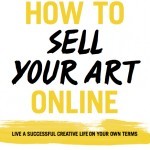 Lots of people have had nice things to say about How to Sell Your Art Online: Live a Successful, Creative Life on Your Own Terms. Read our blog post on why you should buy the book.
Lots of people have had nice things to say about How to Sell Your Art Online: Live a Successful, Creative Life on Your Own Terms. Read our blog post on why you should buy the book.
The book was entirely written in 2015, but the publishing cycle pushed the publication date to Summer 2016, which was fine as it gave me plenty of time to work on the launch. You can watch the launch videos and interviews with artists I highlight in the book by visiting our Youtube channel.
The book is selling well. It hit #1 in several categories on Amazon when it launched, and based on Harper Collins’ sales reports, the book will likely be a solid earner over the next 6 – 12 months.
We Launched a Conference
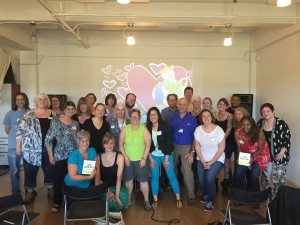 Along with the book launch, we held the first Abundant Artist Conference. This was a big learning experience. When I first announced it, I wanted to hold a 300 person conference at a big fancy venue. But what all of you told me was that you’d rather we have smaller, regional workshops closer to where we are. I ignored that and tried to convince everyone to fly to Portland. TAA ended up losing about $15,000 on the conference, but everyone who attended had great things to say.
Along with the book launch, we held the first Abundant Artist Conference. This was a big learning experience. When I first announced it, I wanted to hold a 300 person conference at a big fancy venue. But what all of you told me was that you’d rather we have smaller, regional workshops closer to where we are. I ignored that and tried to convince everyone to fly to Portland. TAA ended up losing about $15,000 on the conference, but everyone who attended had great things to say.
So in 2017, we’re doing what you asked for – small, regional workshops. We already have tickets sold for Nashville and for Whidbey Island. You can find out more, including how to bring a workshop to your local area, by clicking here.
Cost Rica for Vacation
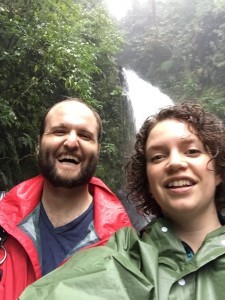 After all of the craziness that was the book and conference launch, we took a much needed vacation in Costa Rica. We hiked around a live volcano, swam in a lava-heated river, saw a bunch of crocodiles and ate some Peruvian Chinese food (yes, that’s a thing, apparently, and its delicious).
After all of the craziness that was the book and conference launch, we took a much needed vacation in Costa Rica. We hiked around a live volcano, swam in a lava-heated river, saw a bunch of crocodiles and ate some Peruvian Chinese food (yes, that’s a thing, apparently, and its delicious).
We also hiked a series of waterfalls in a gorgeous jungle.
Other Highlights from 2016
Theater/Performance
– Bottom in A Midsummer Night’s Dream + Bertrem in All’s Well. Great parts. Amazing experience. Really, really, really fun. I wish Midsummer had run longer. Lesson learned: work with Asae Dean on anything.
– Original Practice Shakespeare company was one of the best things I’ve done in my performing career. It was freeing and exhilarating. I played the Ghost of Hamlet’s father, the apothecary, Sampson and Watchman in Romeo and Juliet, Snout and Mustardseed in Midsummer, Antonio in The Tempest, and several other small parts over the course of a week. Lesson learned: Shakespeare is even more fun than I thought (and I’ve been doing it for 20 years).
– Shadows, a new play, w/ Twilight Theater. I played a dad with a 16 year old son. First time playing a dad character on stage. Lesson learned: people like me with a beard.
Service
– went on several camping and service trips with the teenage boys from church. I serve with them as a mentor and adult supervisor for their Scouting activities
– Carpe Mundi (a nonprofit that helps college Freshmen have a study abroad semester) story telling coaching: every year when they return from their semesters abroad, I help them assimilate their experiences and turn them into stories that they tell for the annual fundraiser.
– I began paying a lot more attention to local politics. I wrote letters to the editor, and have been reading a ton about how politics works at the actual implementation level.
Travel
– NYC for ArtExpo
– San Diego for Traffic & Conversion Summit
– Mount Ranier cabin trip with Charlie, Noah & Jonathan
– Florida for business mastermind
– Utah for sister in law’s wedding
– Portland events: WDS & Tara Gentile’s QPS
– Oregon coast 3 day weekend
– Orlando, Florida for a 3 day retreat with some of the coolest business folks I’ve met
Friends & Family
– TONS of board games. Highlights: Betrayal at House on the Hill, Fire Team Zero, Smash Up.
Health
– Lost 20 pounds
– did a ton of batch cooking so that there was healthy food for me and my wife
– I’m running 15 – 18 miles per week and lifting weights twice per week
Learning
– I read 31 books this year. You can see my reviews if you want to follow me on Goodreads.
– I learned from business courses, like Autoresponder Madness, Breanne Dyck and Tara Gentile’s The Master Class, as well as the conferences that I attended
The Emergent Vision of 2017
“Men are that they might have joy.” – Book of Mormon, 2 Nephi 2:25
The Abundant Artist started out of a deep sense of curiosity in early 2009. I was responding to what I was seeing around me, responding to the ongoing conversation about how the Internet was changing the way art was made and seen. I was deeply intrigued by this conversation. It brought out a sense of joy and wonder because I could connect with everyone on a 1:1 basis, even if they were a world away, via social media.
It’s certainly true that over the last seven years, there have been times that I have become more disconnected from that sense of joy and wonder. TAA has had some growing pains and I’ve become somewhat bogged down in the details – which is a tough place to be for a community full of innovators and artists like us.
But I still love TAA, so this year I’m choosing to focus on joy.
Personally, that means reconnecting with my own spiritual practice, spending more time with friends, traveling to interesting locations, and becoming more involved in my local community’s politics (yes, I do mean politics to find joy).
I want to connect with more artists and other people in person. That means more travel, more in-person workshops, and more public speaking. That could also mean more things like vlogging and podcasting, if it allows me to have fun. We are lining up guests for that now.
Finally, I also want to connect my daily activity with a sense of play. In 2014 and 2015, I spent many Fridays on experimenting with various creative projects like photography, drawing, and various business ideas that were not obvious money makers. I’d like to reimplement that practice, and give myself permission to write about and explore whatever I’m doing on those Fridays.
For now, I’m holding space for an emergent vision, ala Jonathan Fields’ suggestion. I’m not 100% sure what specific things will happen in 2017, but I have some ideas that are pretty exciting.
What are you doing in 2017? I’d love to hear about big projects in the comments.
The post 2016 Year in Review, Part 2: What’s Next? appeared first on Online Marketing for Artists.
2016 Year in Review, Part 1: TAA Community Members
Every year we do a review of what went well here at The Abundant Artist. We’ve usually shared behind the scenes glimpses, which we will do, but I wanted to start off by sharing some of the major victories of 2016 for artists in our community.
TAA Community: Victories in 2016
I sent out an email last week asking TAA Community members to let us know about their major victories. TAA Community members are artists who have purchased courses from TAA, and therefore have access to our private student Facebook group, which is the heart of our community.
There are a lot of artists who previously believed that there’s not a living to be made in selling fine art. By far one of the biggest takeaways this year was that TAA has inspired dozens of artists to believe that its possible to make a career out of art. Here’s a story from Dorothea Leblanc that illustrates this change.
The biggest highlights of my year as an artist:
1. After starting the HTSYAO course in February, I finally believe I CAN be an artist, I CAN sell my work and I CAN approach people about my art.
2. This year I approached a few stores and they’re selling some of my landscape cards – yay!.
3. I have found my niche! I was painting all over the map before this year and have decided to hone in on my most favourite type of painting, which I call “Heirloom Art Pieces” – they’re a highly textured form of abstract art that I’ve been doing for over 6 years (undercover). It is distinct and unusual and I’ve not found anyone doing what I’m doing so far.
4. Last year, the thought of success was scary, but thanks to TAA, I’m also getting past that.
B. The biggest difference between my art business from last year to year is: I didn’t have one.
Here’s a link to one of my most “liked” heirloom art pieces:
A photo posted by DorotheaChristelMariaLeBlanc (@dorothealeblanc) on Dec 14, 2016 at 7:56am PST
Major leaps forward
Lots of artists had a signature sale, something that helped them realize that they could go big. From a small commission for just a few hundred dollars to major commission projects for famous Scottish golf courses, TAA artists launched their careers this year. This story from Judy Jacobs is a great sample.
“2016 was a wonderful year for me, and one of my biggest highlights was being asked to create a five-panel fused glass commission for the Sutter Roseville Oncology Center in Northern California. You can see a photo of it here from my IG feed.This project was especially important to me as I had two friends diagnosed this year with cancer and both were undergoing treatments during the time I was creating these pieces.”
A photo posted by J U D Y J A C O B S (@judyjacobsart) on Sep 26, 2016 at 10:38am PDT
But it didn’t end there. Lots of artists had not just signature sales, but also other moments of realization that validated their choice to pursue art in a serious way.
Deidre Tao
I’d also just like to share that as a mom of two, I am so glad to report that my kids (ages 8 and 11) are proud of me and are at an age when they are beginning to see and appreciate what I bring to our family life as an artist. And I am so proud of them. We had a Christmas Art Salon Open House at our condo a couple of weeks ago, and they both dressed up (son in a bow tie and daughter in her Hermione Granger costume) and served hot cocoa to all their kid friends who came with their parents (some of whom bought prints and notecards as gifts).
My husband handled the sales and wrote receipts so I could schmooze. Kids and families can be part of our artist adventure and we can feel like a team. It was bonding and fun. I think the kids are learning about small business skills along the way to boot.
Deidre had a painting hung in city hall, which you can see at this link.
Real financial success showed up for some artists too.
Mary Kemp
Biggest success of the year: creating a cohesive series of work and to date selling a quarter of it.
Now I am in the process of narrowing down what I do, and I realise my target market is not as young as I thought it was. Plus I must have sold between 25 and 40% more than last year.
Mary’s website.
Mike Brennan

Getting hired to create art by Kweku Mandela (Nelson Mandela’s Grandson) who is an activist involved in Global Citizen events. This is the third year he has hired me to create art centered around the Global Citizen event that takes place in Central Park, NYC the past few Septembers.
This year he had me create art for 5 of the headlining acts – Kendrick Lamar, Major Lazer, Rihanna, Demi Lovato, and Metallica. He personally handed my art to each artist the day of the event. I blogged about it and how it all came about here – (with samples).
Taking Massive Action
It was really fun to teach and collaborate with so may incredible artists this year. The ones who really inspired me were the ones who took whatever we offered here at TAA, and took massive action to grow their art business as much as possible. The best example of this was from Dawn Allen.
Dawn Allen
“My new year’s resolution for 2016 was to follow as all of the free advice available on TAA website and see how far I could get with my new business as an artist. I did purchase the Instagram program and your book. I watched/attended all of your free webinars, read your website, and participated in discussions in the TAA Facebook group.
I was starting from scratch with my art business other than about 12 finished pieces of art (and many years of experience creating art).
This is what I accomplished (starting from scratch):
Created an e-commerce website
started a facebook page (600+ followers)
started an instagram page (250 + followers)
started a mailing list now over 250 people and send out newsletters every 2-3 weeks
Created over 60 art quilts (20 large pieces)
had 2 solo exhibits (one in a local gallery and one at a vineyard)
was the spotlight artist in Quilting Arts magazine
was in my local newspaper twice with color photos
grossed $5,000 in sales
showed my art in four juried group exhibits (including Whistler House, Brush Gallery, and Highfield Hall and Gardens)2016 was a year of figuring out what kind of art I want to make and sell, and a year of discovering how to sell my art. I feel like I need at least 6 more months of refinement before I can settle in to a sales rhythm but I am very pleased with my results so far! I plan to take
[How to Sell Your Art Online]
sometime in 2017 or 2018.
Thank you for being so generous with your knowledge and information. I tried to repay you by referring you to other artists often.”
Marigny Goodyear is another great example. In addition to setting up her website, social media profiles, group shows and landing her first paid commission, she had this to say.
“I now have a working routine and days of the week set when I write my blog, tend to social media postings, cold calling and compiling lists of leads, and of course, studio time. The admin to studio time ratio is about half and half for me.
Marketing is becoming clearer. This has always been my least comfortable topic but I’m getting the hang of it little by little.
I quit my day job!!!!! I find myself in a position where I am able to quit my day job, which I’ve been at for 8 years, and focus on my art business. My last day isJanuary 27, 2017. OMG.
Thank you Cory. Your book, videos, short courses and challenges helped me so much think of my art not just as a creative passion, but as a business. I am ready for 2017! Lets do this!
Marigny’s website is MarignyGoodyearArt.com.
Chelle Destefano ChelleDestefano.com
The biggest highlights of my year were being chosen, as a Deaf artist, to have a solo exhibition in Paris, London and Bath, winning a big funding grant to take my art and myself over to Europe for my solo exhibitions.
Trine Churchill
This past month and a half, I have sold 9 paintings from my 30 days series, 1 watercolor, and 1 very large drawing.
If there is one overall word that I think could describe my main highlight for the year, it would be connection.
I send out a weekly email with a watercolor or pen drawing, and a few lines of thoughts about it. Although, I only have a few subscribers for the weekly email, people are loving it, and some tell me waiting for it to come into their inbox. This keeps me motivated and not only connected with them but also connected with myself, my inner source of inspiration, and with my commitment to making art.
Here’s a link to Trine’s 30 Day Painting Project.
Evelyn Espinoza
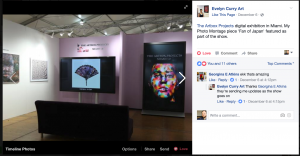
Quadrupling my income! Exhibiting here in Japan. Winning art competitions.
I started the year with a large Art Fair and that’s where the networking began; creating opportunities. I received several commissions and sold more than I ever have. Myself as an artist and my artwork was spread through word of mouth. I’ve participated in several Art Fairs throughout the year and had very successful days. It’s helps being the minority for what I do. There are many portrait photographers in the community, and many crafters; but not too many artists who utilize photography, and paint.
I spent 2014-2015 completing the
[ How to Sell Your Art Online ]
Course, and the Facebook Course through The Abundant Artist. I relocated 4 times and had a baby, so I had to wait until we got situated and settled before putting the course content into practice. I’m a military wife, which means relocating every 3 years. We currently live in Japan, so our surrounding (English speaking) community is small.
A large contributor in my year’s success was becoming part of the church community. People got to know me before they knew I was an artist. I think that helped immensely. Everyone is very supportive and connected me to other individuals/forwarded my name when a painting commission or gallery opening came up.
In hindsight, I see how useful and essential so much of the TAA course information has been to my art career. I see how people want to get to know you, the artist, and this does influence their decision to purchase; how true it is about repeat customers, building your mailing list, social network consistency.
Whew! That was a lot of success stories!
I don’t mean to be so excessive, but it’s just a lot of fun. In the next blog post, we’re going to cover the year in review for TAA, the business.
Do you have any additional major victories to share? Do so in the comments.
The post 2016 Year in Review, Part 1: TAA Community Members appeared first on Online Marketing for Artists.
December 19, 2016
Instagram Challenge, Survey Results & What’s Next
For the last two weeks, we’ve been running a challenge over on Instagram to see how many followers and sales you can get. It was a smashing success with over 1400 artists signed up for the challenge.
Lots of people probably want to know what’s next for TAA.
Last Friday morning, I had finished going through the results of a survey that we did. You may have participated. Over 500 artists told us about their biggest challenges. I decided to share the results in a Facebook Live video and talk about what that means for you. You can watch the video below, or at this link.
Here’s the highlights from the video.
Doing Nothing. The most common response from artists who are struggling with sales is that they are doing nothing to fix it.. Because you participated in the Instagram Challenge, this is not you. But it was surprising to me.
On Thursday, I spoke with an African artist who started with nothing a year ago finished her year with $50,000. In the Fall of 2015, she signed up for our How to Sell Your Art Online course, with just a few hundred dollars left in the bank. She took massive action and grew her art business to $50,000 in a year. More to come on that later.
There were 5 Major Obstacles that survey respondents outlined. After the Christmas break, TAA will be releasing some new content addressing each of these areas. Stay tuned for that.
Fear of showing your work
Time: too busy with your day job
Productivity: what is the most optimal, cost effective way of building a body of work?
Where do I get started? What do I do next?
How do I market and share my work and get collectors instead of fans?
Instagram challenge results. Obviously we are still collecting stories since it just ended Friday, but a few quick facts.
As of Friday morning, there were over 2700 Instagram posts under the #taaigchallenge hashtag. That’s a lot of action. Well done! Also, that number doesn’t count the Instagram Stories and Live videos that disappear after posting.
Here’s some highlights from the challenge.
Sara O’Connor sold over $700 worth of original art in the first week of the challenge.
A photo posted by Sara O’Connor Fine Art (SOFA) (@saraoconnorfineart) on Dec 6, 2016 at 8:03pm PST
Anne Kindl sold several pieces in her new series during the challenge.
The Pastel Pop Up will be open on my website until 9 pm tonight

November 28, 2016
The Importance of Following Successful Living Artists
-Let’s Define Success
Where do you begin? What defines a successful living artist? What is your definition of a successful living artist? Why is it even important to follow artists that are successful? Please continue reading and I will explain.
Seek, and Ye Shall Find
In today’s world full with technological advancement as well as the inflation of resources, it is not difficult to find successful artists to follow. Even before the age of technology and the advancements of the internet, one could find successful artists to apprentice under. There are successful artists all around us.
4 Key Factors to Being Successful
It is to my belief that an artist’s brand awareness, financial value, published works, and network define their success. Of course, a lot more detail goes into to making these individuals prosper, but these four key factors play a major role defining their overall value.
I have heard countless numbers of times of people saying “Success is what you make it,” and I certainly understand that we define where we reach the point we can label ourselves successful. In this regard success is relative to each person. However, when it comes down to business and making a living as an artist the fact remains that finance is a big part of it.
Following artists that it’s apparent they are doing well financially with their business is important. Now that that’s out of the way, here are some reasons why it is important to follow artists that are doing well in your niche.
Start by Finding a Role Model Artist You Admire 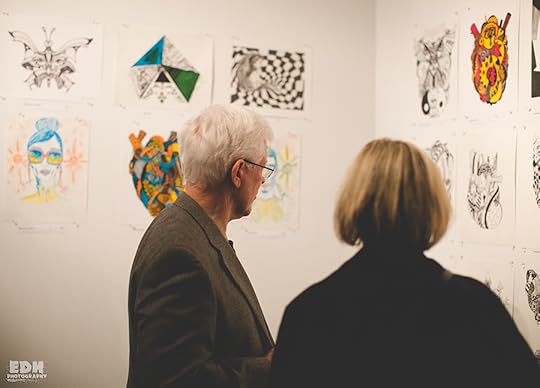
Finding an artist whose work you admire can do many things for you without knowing it. Set your goal after having a collection of artists you look up to because of their style and quality of work produced.
Here are Some Examples of Very Different Successful Artists:
These are 3 artists out of many that I admire for certain reasons. Each one of these artists practices different forms of art. However, if you follow their creative career there is a lot to learn.
Graphic Artist | Shepard Fairey of OBEY
Fairey has created a brand that is a giant with a distinguished look in design. He has taken the art that he creates with a unique style and created products for a targeted audience that has been well received. When you look at the OBEY brand although it’s divided between casual fashion and art collectibles, it’s all marketed as a business.
Be Political. Be Fashionable. Be Something
However, the background story behind the rise of Shepard Fairey’s success is a unique one. The use of social and political critique through his work allowed him to capture many people’s attention. His more recognizable artwork is an iconic Hope illustration portrait he designed of President Obama during the 2008 election.
Fairey became famously infamous for the presidential candidate poster he designs because he also utilized it to support President Obama’s campaign. The way he did it was through mass producing posters and stickers for the “HOPE” campaign. The poster also created some trouble for Fairey because he utilized a photographer’s photograph of President Obama without permission.
He then went on to create a 9-storey mural in tribute to Nelson Mandela in 2014, which was published by publications like RESPECT Magazine and picked up by countless of other media outlets.
The key takeaway from his story is that in his contribution to supporting something like a political movement; the “HOPE” campaign, he was able to also brand and build his name.
How Does Sheperd Fairey Make His Income?
*Sheperd Fairey is a successful living artist because he created art that tied into politics. Fairey sells his prints from $35 to $100 on his Obey Giant online store along with his apparel line designs.
Renowned Sculptor Jeff Koons
Who would have thought that a stainless steel sculpture of a balloon could earn you a fortune?
Jeff Koons is a modern day contemporary version of Michaelangelo from the 13th and 14th century. The reason I can say this is because he did something that made an impact on art history itself. His name, which in his case is his brand will continue to live on long after he is gone because of his stainless steel sculptures and their subject matter.
Now, Koons did not pioneer stainless steel sculptures as the first artist to ever do this style of sculpture. However, his expression to imply sex, race, gender, and fame into his art were done unconventionally. After completing his studies at the School of the Art Institute of Chicago, he would work to place his work in exhibitions across the globe, which was successful for him.
The Shift in Recognition
Like Sheperd Fairey of Obey, there was also a turning point in Jeff Koons career after he debuted a sculpture of Michael Jackson and chimp Bubbles in 1988. This sculpture sparked a lot of attention and contributed to building his name.
I once heard that it only takes a witty idea for you to prosper. We live in a time where almost every creative person can claim that they are an artist. However, you may not be the first to do something but can still succeed.
You also do not have to create something that causes you to become famous like these artists, but you can take what you are capable of doing as an artist and make it your business.
We Are More Resourceful Now
We have so many tools at our disposal that neither Jeff Koons nor Sheperd Fairey had during the earlier parts of their careers. Though the developments of a business plan and creative marketing strategies you can build a successful business for your art.
Today we can produce Instagram posts, Twitter campaigns, Youtube video ads, and many other forms of digital promotion that was not available for these artists when they first began.
Where Does Jeff Koons’s Money Come From?
*Although Jeff Koons is now considered a famous artist, he worked his way to building his name to be the successful sculptor that he is today. He does commission sculptures ranging from thousands to millions. According to Artnet His highest sold sculpture Balloon Dog was sold for $58.4 million.
Independent Musician | Chance the Rapper
If you have never heard of Chance the Rapper and can’t imagine why a rapper is in this article, please continue reading.
Let’s First Talk Various Industries
Every industry goes through changes. Art, Fashion, Automotive, Health, Music, and the list go on. With changes in each industry at a certain point and time, we must learn to adapt and adjust our ways of thinking.
The music industry today is not the same it was in the 1990’s or 1960’s. Today we have independent musicians and record companies that are very successful without having millions of dollars to mass distribute CD’s to sell. Musicians today can build their own followers and do not need advances in order to become successful. Again, with the age of the internet, we can do so much more.
Chance The Rapper’s Story
Chance The Rapper is an excellent example of successful independent musicians. The rapper released a mixtape during a 10-day high school suspension entitled 10 Day in 2012, which was published online for free. The mixtape was picked by Complex Magazine who highlighted 10 rising talents in Chicago and included Chance The Rapper in the feature. From there on other musicians started to notice him, noticeably Childish Gambino (Donald Glover) an actor turned rapper gave him the opportunity to appear on another mixtape. From there he would begin touring with Gambino, which lead to him releasing another free mixtape entitled Acid Rap.
The Success of Acid Rap
Following the Acid Rap mixtape release in 2013 many more music celebrities started to notice Chance The Rapper. The mixtape was hosted on the free mixtape hosting site Datpiff and gained over 1.4 million downloads and counting.
How Does Chance The Rapper Make Money Giving Away Free Music?
*Chance The Rapper as of today still produce a lot of free music for the fans he has gained over the few years by giving out free music. His income comes primarily from touring and selling or merchandise, such as graphic t-shirts, posters, and collectibles.
Three of a Kind? Not So Much
With these three very different artists I learned that their success came in various ways. Nevertheless, all three are doing very well financially with their business. These are people that could walk past you at the mall and you would not recognize them. The truth is you don’t have to be famous to sell your art. Below is another example of a fellow artist that reside in the Midwest I am connected to.
Midwest Visual Batik Artist – Patty Talbert
An artist that I wrote about on my blog named Patty Talbert paints using a batik method. She produces art series and coordinates solo exhibitions for herself where she sells her work physically from $50-$500. I attended an art show where she created over 130+ paintings in 4 weeks using words of affirmation as the creative inspiration. The idea behind her exhibition was created to deliver a positive message to the community surrounding her. When I spoke to her during the show she mentioned that we need to impact our communities in a positive manner as artists.
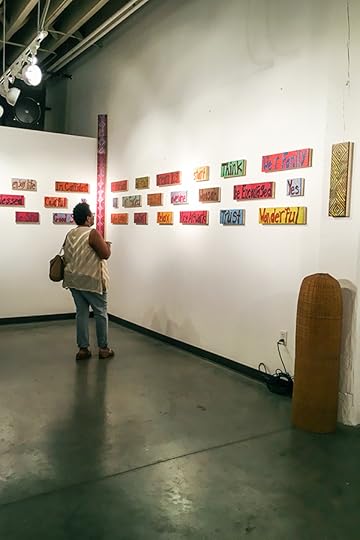
Talbert has a community and network she has developed herself that allow her to continue to produce art along with selling her work.
All in all, your brand awareness, financial value, published works, and the network you create will define your success. The purpose behind your art will also contribute to your success as a living artist. Through sharing knowledge about these artists, I hope you are inspired to see the various ways you can build your own success with your art.
Is There A Step By Step Way To Succeed With Your Art
Truly there is no exact formula. In order for you’re to become a successful living artist yourself, you will have to balance multiple things and develop some business skills. Now, if you are thinking “Oh no”, “Well, I’m done for”, and “How am I suppose to do that?” My answer is that you must make it a goal to learn every day. As much as it is important that you create art every day and share your work with someone every day. You must not forget to continue your learning.
Make Your Art More Than Just A Visual
Your art must become your business. You must have a business plan and strategy on how you are going to get your artwork out there. With the wealth of knowledge that is available at libraries and online websites like The Abundant Artist, you can learn about marketing and how to develop a plan to sell your art. If you are still not able to develop your business skills and want to solely focus on creating your art, hire a business coach to help you with your goal.
Going to a college or university will not make you rich, but it will help sharpen your skills and present a networking opportunity for you. On the other hand, we have Youtube, countless numbers of blogs like The Abundant Artist, and online training course programs that cost less to nothing for the information you need. Finding one that fits your personality and learning style is one of the important factors that will enable you to work your way to being a successful artist.
5 Great Resources for Finding Living Artists That Art Doing Well
Behance.net – Professional network of artists, photographers, illustrators, and designers and more.
ArtStation.com – Another professional network where digital artists are thriving.
Instagram.com – Social Network App
Pinterest.com – Social Network and App for content sharing, but more dynamic with its search system.
Etsy.com – An online art store/network created for artists that focus more on selling a physical product without having their own website.
Some of these websites such as Instagram and Etsy, I know The Abundant Artist creator Cory Huff has talked about. However, the other sites are also recommended depending on which path you plan to head with your art.
All in all, it is important for us as artists to follow successful living artists. The information you will learn about their artworks, story, and experience will be very beneficial to you. For one, you can get a spark of new ideas creatively, learn how they connected with their supporters, and develop by watching them.
Studying other artists will give you ideas on things you could try with your own art business and even inspire the style of art you create. If you make it an effort to never stop learning and always have the mindset to grow, surely you will also become a successful artist.
Do you follow successful artists? If so, how has this helped you as an artist? Leave your thoughts regarding the article.
Author:
Kenal Louis is a digital illustrator who develops a collection of art series. His most noticeable series thus far is the Royalty Art series, which was featured on AFROPUNK and Kaltblut magazine in Berlin, Germany. The art series is a collection of celebrity portraits digitally painted in gold in an immortalized state. The Royalty Art series include portraits of The Rock (Dwayne Johnson), Zendaya Coleman, Rihanna, and other recognizable public figures. Louis shares and promotes online through his blog Kenalsworld.com. Currently based in Nebraska, Louis enjoys creating art daily and posts much of his work process on Instagram.
The post The Importance of Following Successful Living Artists appeared first on Online Marketing for Artists.
November 22, 2016
Before You Build Your Artist Website, Do This…
A lot of artists decide they’re going to build a website, jump online, Google a few website options, and then pick one at random because they don’t have good criteria for making an informed decision on how to purchase a website service.
As we’re leading up to the Artist Website Bootcamp, starting next week on Monday November 28, I’m getting lots of questions about how to get started on a website. Here are a few quick tips.
Do your research. Most artists don’t do this. For most professional website builders, they’ll spend as much time doing this as they’ll spend actually building the site. They’ll not only research competitive website and sites similar to what they want to build, but also build out swipe files or pinboards. They identify how the website is going to stand out before it is ever built. This blog post talks about the need for market research and how to get started. Our upcoming Bootcamp and course, Artist Websites That Sell, goes deep into how to do that research.
Understand what’s available. Do you know the difference between WordPress.com and WordPress.org? How is Shopify different from Squarespace, and how are all of them different from the various artist-specific website offerings like ArtStoreFronts or FineArtStudiosOnline? Here’s a hint: decide what you want your website to do before you evaluate the services. Check out the artist website checklist, a free download for understanding what should go on your website. Also check out our guide for picking your artist website.
Offer ecommerce. I was recently contacted by an artist website service that does not offer ecommerce, the ability to sell art directly from the website with a credit card or Paypal. They wanted me to recommend the service to artists, and I told them to get back to me when they have ecommerce. If you only accept commission work, or you have a high end gallery that sells all of your art, then it might make sense not to offer ecommerce, but there are very few other exceptions.
Here’s our guide on how to get started with ecommerce.
Sign Up for the Bootcamp. We start Monday, November 28. Each day at 8:00 AM Pacific Time, we will have a one hour call for you to ask questions about your website and see how we help other artists build great websites.
Click here to sign up for the bootcamp. Spaces are limited. As of right now, there’s only 12 spots remaining.
The post Before You Build Your Artist Website, Do This… appeared first on Online Marketing for Artists.
The Abundant Artist Goodreads blog
- Cory Huff's profile
- 31 followers


